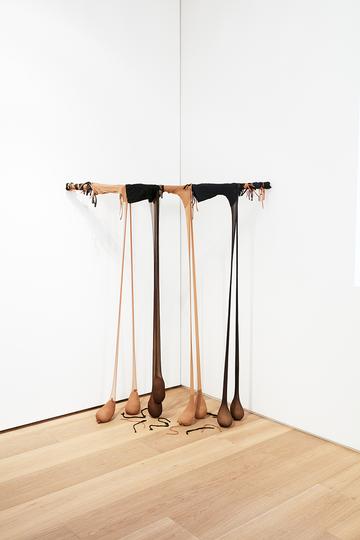FEMALE STUDY: SENGA NENGUDI'S FLESH & GENDER IDENTITY
I’ve made it a point to highlight underrepresented women in western art history, and I have written about Latin Americans and Eastern Europeans, and yet still no black artists. But I mean, how many black artists are mentioned in the same breath as Max Bill? Why are there still entire books dedicated to black artists, rather than integrating them with their contemporaries? Why is it so hard to even find black artists in history?
I'm half Filipino and half Irish. Growing up I never realized I was racially different from anyone, as my corner of California was racially diverse. However, as I've gotten older, racial identity has become very important to me. The Filipino family name, Bagtazo, was chosen in homage to this.
For black artists in America, racial identity seems inextricably related to their work. It's as if one cannot be a black artist without discussing being black. And with good reason, as I think there is no racial identity as inescapable in the US. When I decided to write about a black artist, I will admit I didn't know where to begin. But then I found American artist, Senga Nengundi.
Senga Nengudi, was born in Chicago in 1943, but grew up in Los Angeles. Originally named Sue Irons, Nengudi took her working name early in her career when a friend from the former Zaire started calling her by that name.
Senga Nengudi was part of the avant-garde black art scenes in New York City and Los Angeles during the 1960s and 1970s. Some of my favorite of her works involve panty hose. Panty hose are one of the few things that have catered to the varying shades of skin tones since before the civil rights movement, and so I think it’s super cool that Nengudi used them in her work. (Because duh, all women are candidates for shaming and social decency norms).
In 1977, Nengudi worked with Hassinger for a performance piece in the same vein as RSVP, improvising movement entangled in a web of pantyhose at Just Above Midtown Gallery in NYC. According to Nengudi, the performance was made to symbolize how women are restricted by societal gender norms. These performances were captured on film in stills, where Nengudi appeared as an androgynous figure, in attempt to defy gender definitions.
Since moving to New York, I’ve really missed the gender neutral values of the West Coast. Black boys in Oakland wear earrings with vintage turbans that one may have seen their grandmothers wearing in the 60s. Young boys in LA wear skirts and paint their nails. To think that Nengundi was doing this in New York in the 70s blows my mind because it was not only advanced, but it must have been viewed as extremely radical.
In 1979, Nengudi performed Ceremony for Freeway Fets under a freeway overpass on Pico Boulevard in Los Angeles. The performance was made with her collaborators, Hammons and Hassinger from Studio Z Collective. Nengudi crafted costumes and headdresses from pantyhose for the performers. Hammons and Hassinger played the roles of male and female spirits, while Nengudi's character represented a spirit that united the genders. Both the performance and music were improvised.
I was able to find a slideshow with the original music, and an audio interview of Nengudi, which can be viewed below:
In 2007, during her residency at the Fabric Workshop and Museum in Philadelphia, she created a video installation entitled "Warp Trance.". The film was made to communicate the experiences of textile workers. (As some of you know, I have been working in manufacturing for over a decade, and so I'm really into this, even though I think the aesthetic is v 2007 video art).
From 1970 through the present day, Nengudi has performed nearly thirty original pieces, and has exhibited in sixty-five group and solo shows combined. Nengudi is a prolific artist whose focus on racial and ethnic identity has remained strong throughout her work. She also explored gender politics and identity from the beginning of her career in the 1970s, a topic that society has just begun to discuss publicly in the last few years.
I actually saw Senga Nengudi's work in Los Angeles at WACK!: Art and the Feminist Revolution exhibition at the MOCA in Los Angeles in 2007 without realizing it. The show in its entirety had young me in tears, but I remember looking at her pantyhose piece and thinking how great it was. The installation looked like boobs and balls all at once. And I was all about the nipple back then, so that piece really got me.
Nengudi continues to work today from her Colorado Springs studio. Since 2007, she has re-performed many of her early works, as well as exhibited a number of retrospectives.
BIBLIOGRAPHY
The Improvised Body: The Reemergence of Senga Nengudi, Noel Black. September 2014, Hyperallergic.
Senga Negundi, African American Performance Art Archive
Senga Nengudi: She Twists, Knots and Pulls to Near Breaking What Other Women Fear Will Get Snagged and Run, Gylbert Coker. International Review of African American Art
Courtney Bagtazo, © Bagtazo 2016
READ THE ENTIRE BLOG






